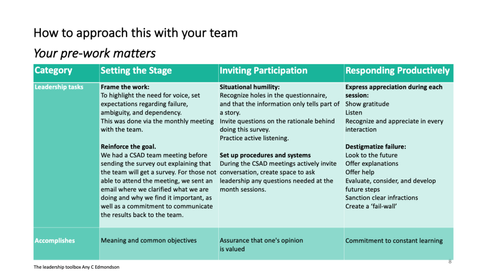Framework for Psychological Safety in High Performing Teams
- Chrissy Wesh

- Nov 13, 2022
- 3 min read
Updated: Mar 23, 2023

What is Psychological Safety?
An environment where employees feel safe to voice ideas, willingly seek feedback, provide honest feedback, collaborate, take risks and experiment. A place where you are not rejected to be yourself, where you can have positive interactions and constructive conflict. A place where you can learn from mistakes.
What makes psychological safety difficult to measure?
It’s a feeling: It’s a vibe, its an intangible underbelly that tell us to be quiet when we think we should speak.
It’s about the feelings of a group: You don’t create this feeling alone. You create this feeling of safety with others. The interpretation of how safe a space is depends also how others interpret that space.
Its changeable: You can feel safe in some sub-groups and exposed in other projects groups. How safe you feel can change with the context of the group setting.
Not all Feelings are created Equal: Different feelings matter more to some than others. Some people like being the centre of attention others fear it. As such there is not one approach.
If your in the business of product, innovation & creativity Psychological safety brings with it many benefits
Innovation: Sense of humour increases as does problem solving and opposable thought, which are the underlying processes for creativity and innovation. (Carmeli & Gittell, 2009)
Creativity: When the workplace is safe but stimulating groups can sustain the creative phases of growth. (Delizonna, 2017 )
Faster Learning: Learning from failure is also a trait of pioneering companies who innovate at speed. (Edmondson & Cannon, 2005)
Culture: Companies that hope to retain their talent should invest in their team by maintaining a healthy culture of openness and safety. (Detert & Edmondson)
Success: Individuals become open minded, robust, driven, and determined when they feel safe. (Delizonna, 2017 )
Revenue: In companies where psychological safety was present it was seen to be positively corelated to firm impact in two areas including return on assets and process innovation. (Baer & Frese, 2003)
Creating and maintaining a high performing team needs fast learning, creativity, innovation, the ability to make mistakes & move on, & to speak out against issues. Without it your team cannot perform.
The 19 statements you need to rate on a Likert Scale Leadership Part
If I had a question or was unsure of something in relation to my role at work, I could ask my team leader
I can communicate my opinions about work issues with my team leader
I can speak up about personal problems or disagreements to my team leader
My team leader encourages and supports me to take on new tasks or to learn how to do things I have never done before.
If I speak up/voice my opinion,
I know that my input is valued by my team leader
I can speak up with recommendations/ ideas for new projects or changes in procedures to my team leader
If I made a mistake on this team, I would feel safe speaking up to my team leader
If I saw a colleague making a mistake, I would feel safe speaking up to my team leader
If I had a problem in this company, I could depend on my team leader to be my advocate
Peers Part
If I had a question or was unsure of something in relation to my role at work, I could ask my peers
I can communicate my opinions about work issues with my peers
I can speak up about personal issues to my peers
I can speak up with recommendations/ ideas for new projects or changes in procedures to my peers
If I made a mistake on this team, I would feel safe speaking up to my peers
If I saw a colleague making a mistake, I would feel safe speaking up to this colleague
If I speak up/voice my opinion, I know that my input is valued by my peers
The Team
It is easy to ask other members of this team for help
People keep each other informed about work related issues in the team
There are real attempts to share information throughout the team
What the steps for a psychologically safe team?
Set the stage: Prep the team toward the goal of doing this survey so they understand the value.
Anonymous Surveys: The ability to say what’s needed with no repercussions will help you get to hard truths
Analyse your data: Looking at the details allows you to plan the right interventions
Run an Intervention: Plan activities that directly help the metric you want to shift and then test again.
Make it part of team strategy: You only know if you are successful if this runs on a cadence.
I hope the steps, advice, approach and framework help you measure and create environments where you can have and maintain a high performing team as their leader. Good Luck!














